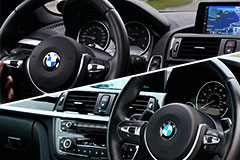How to Convert a Car from a Right to a Left-hand Drive? - Vol.408
Despite the fact that most countries use the left-hand driving system, right-hand driving isn't as rare as you may think. In fact, around 25% of the world uses this system. It was introduced by Great Britain, after which multiple countries started adopting it.

A good example is Japan, where the right-hand system is the default one, although left-hand vehicles are allowed too. If you decide to import a used car from Japan or any country that uses right-hand drive (RHD), you should always make sure to take a look at your country's traffic regulations.
Conversion Procedure
Since some countries impose very strict road rules, converting a vehicle from RHD to left-hand drive (LHD) is often mandatory. Keep in mind that this is not a simple process, and that it should always be done by a trained professional. This is especially important if you're importing a vehicle from Japan, since Japanese manufacturers are known for using complex technology in their cars.
Here's what the conversion process usually consists of:
- Steering wheel repositioning
- Dashboard repositioning
- Rack and pinion exchange
- Shift knob replacement
- Side mirror repositioning and angle adjustment
Steps in the Conversion Process
Some of the tasks listed above are easier than others, but overall it's not an easy procedure. If you want to perform the conversion, you'll have to do the following:
1. Dismantle the entire dashboard, as well as everything underneath it, and reposition it. The wiring harness doesn't need to be removed or repositioned, you can just invert it.
2. Replace the steering rack assembly with the LHD one. Keep in mind that the conversion may affect the air bags, so it's necessary to pay close attention in order to not damage them.
3. Reposition the pedal assembly. If you drive a manual, this involves dismantling the mounts of all three pedals, removing, and reinstalling them.
4. Reposition and realign the brake master cylinder. It's very important to let a trained mechanic do this, since even the slightest mistake can endanger your safety.
5. Reposition the accessories found at the firewall. This includes AC ducts, blower motor, and different cables and wires. Since the firewall is between the engine bay and the passenger compartment, you need to remove the engine and transmission to access it.
6. Adjust the doors. If your car has the door controls in the middle section, there's no need to change anything. But if the controls are installed on the doors, you have to remove and replace them.
7. Remove and replace the wiper mechanism and motor.
After the conversion is done, every car must pass inspection. Once it does, you'll be good to go.
What to Keep in Mind?
If you plan on importing a car from Japan, and your country's laws state that you can't import a right-hand drive car, you need to make sure to find a replacement service that will perform a pre-shipping conversion. If that's not the case, you can find a local mechanic and let him do it. And in case you're a professional yourself, you can purchase a conversion kit and do it on your own, but make sure to take the car to a government-approved inspection station afterwards.
As far as the price goes, it's not that high, especially if you take into account the fact that the conversion must be done correctly in order to ensure your safety. It's always a good idea to invest in your car by paying a professional than try to do it yourself. Always make sure to do a bit of research regarding your county's laws and available conversion options, and you can rest assured you'll be able to drive your new car with no risk.